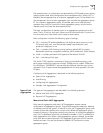
44 CHAPTER 2: PORT CONFIGURATION
In a manual or static LACP aggregation group, its ports may be in an active or
inactive state. However, only the active ports can receive user service packets. The
active port with the minimum port number serves as the master port, while others
act as sub-ports.
In a manual aggregation group, the system sets the ports to active or inactive state
based on these rules:
■ The system sets the port with the highest priority to active state, and others to
inactive state based on the following descending order of priority levels:
■ full duplex/high speed
■ full duplex/low speed
■ half duplex/high speed
■ half duplex/low speed
■ The system sets ports to inactive state if they cannot aggregate with the active
port with the lowest port number due to a hardware limit, for example, if
trans-board aggregation is not available.
■ The system sets ports to inactive state if their basic configurations are different
from the basic configuration of the active port with the lowest port number.
In a static LACP aggregation group, the system sets the ports to active or inactive
state based on these rules:
■ The system sets the port with the highest priority to active state, and others to
inactive state based on the following descending order of priority levels:
■ full duplex/high speed
■ full duplex/low speed
■ half duplex/high speed
■ half duplex/low speed
■ If the Switch 7750 is connected to a peer device on which the maximum
number of ports in a link aggregation is smaller than on the Switch 7750, the
Switch 7750 sets to active the number of ports that correspond to the peer’s
maximum. The Switch 7750 sets its extra ports to inactive.
■ The system sets ports to inactive if they cannot aggregate with the active port
with the lowest port number because of a hardware limit, for example, if
trans-board aggregation is not available.
■ The system sets ports to inactive if their basic configurations are different from
the basic configuration of the active port with lowest port number.
Since a defined number of ports can be supported in an aggregation group, then
if the active ports in an aggregation group exceed the port quantity threshold for
that group, the system shall set some ports with smaller port numbers (in
ascending order) as selected ports and others as standby ports. Both selected and
standby ports can transceive LACP protocol, but standby ports cannot forward
user service packets.


















